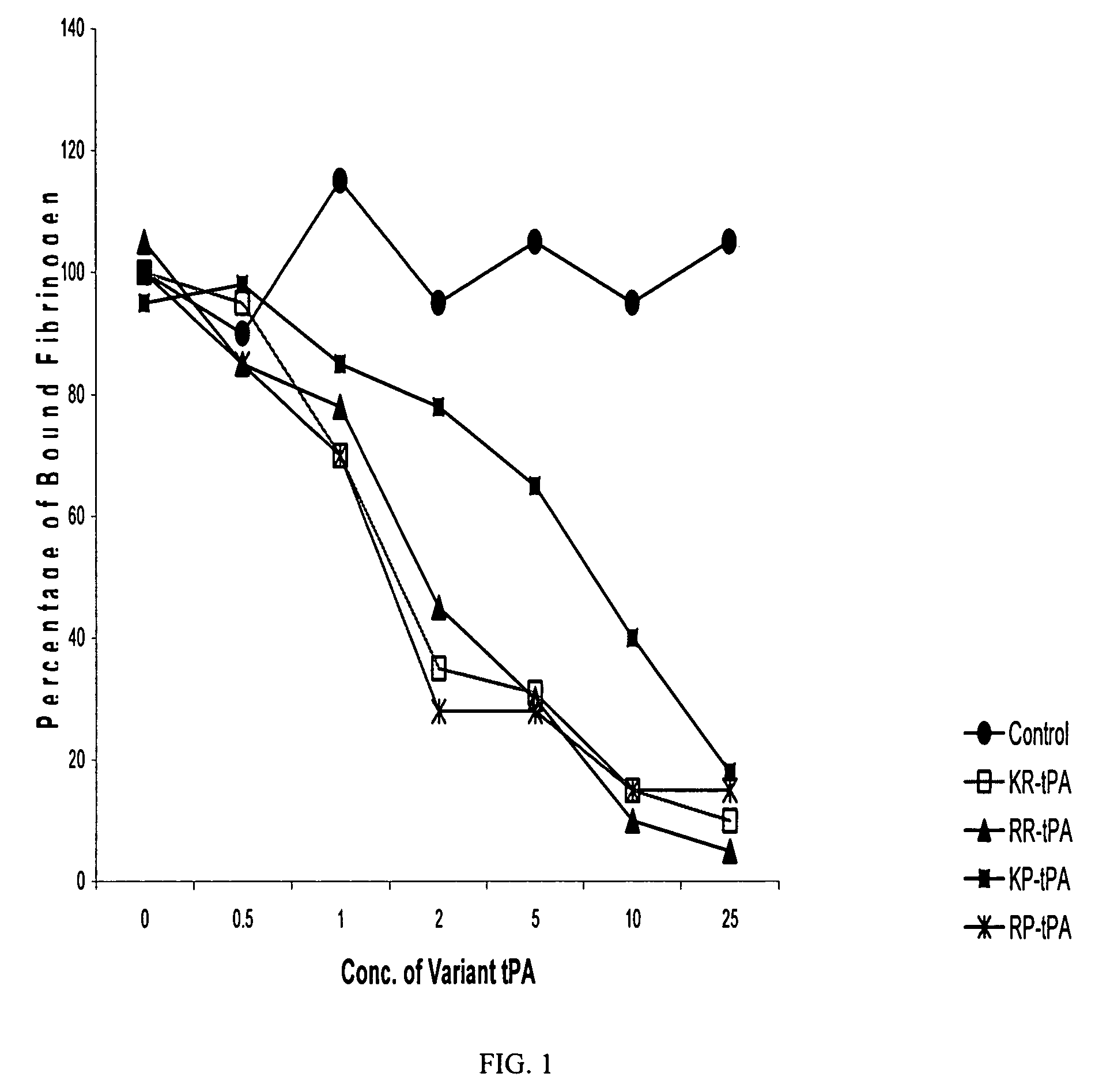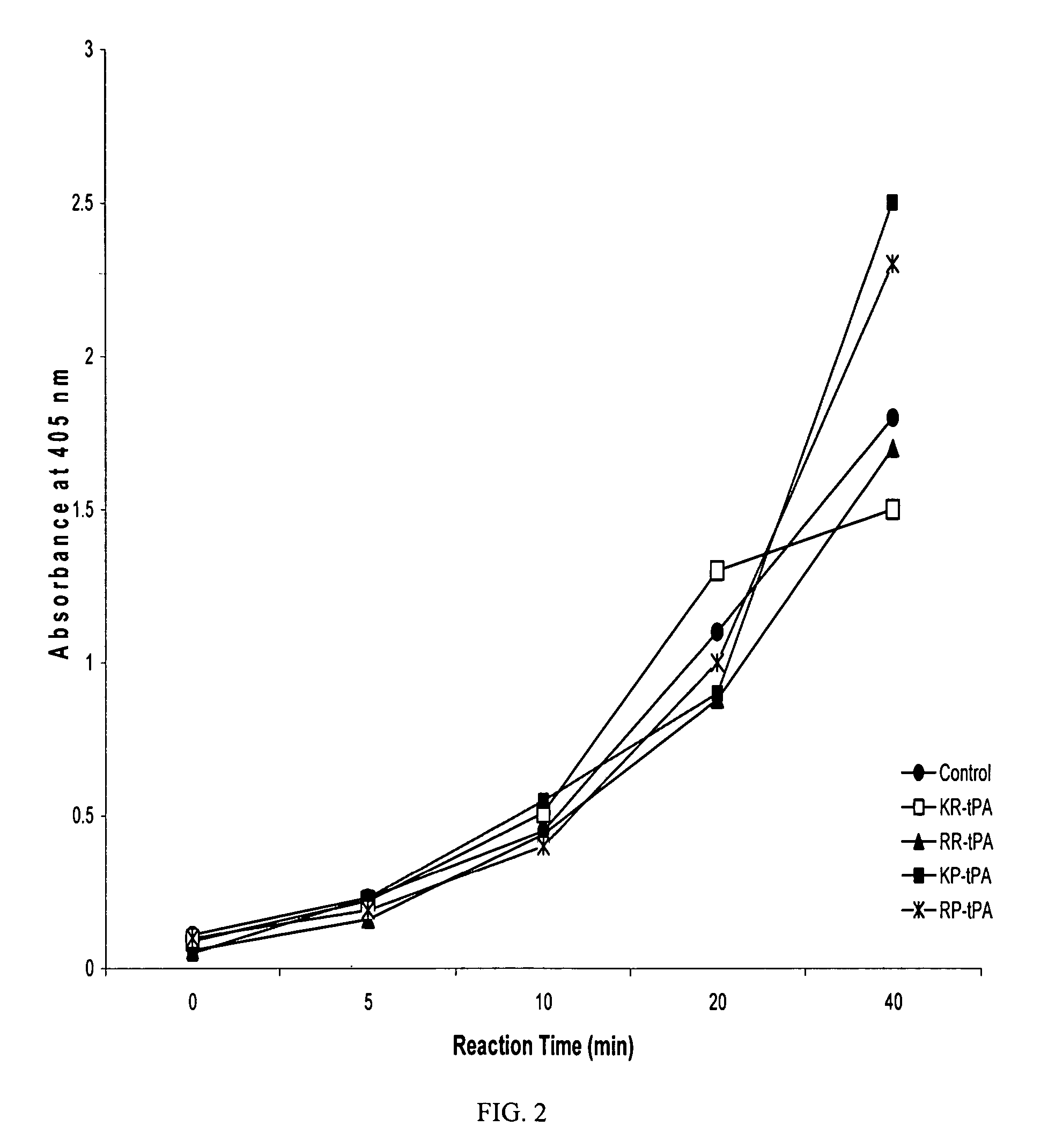Bifunctional variants of recombinant tissue-type plasminogen activator with platelet aggregation inhibitory activity
a plasminogen activator and platelet technology, applied in the direction of drug compositions, peptide/protein ingredients, extracellular fluid disorder, etc., can solve the problems of increased risk of bleeding, short half-life of enzymes, and excessive degradation of fibrin,
- Summary
- Abstract
- Description
- Claims
- Application Information
AI Technical Summary
Problems solved by technology
Method used
Image
Examples
example 1
Construction of Vectors Encoding Single-Chain tPA Variants Containing the K2C Domains
[0051]A variety of vectors and clones expressing the unique features of the modified tPA of the present invention can be generated using conventional recombinant DNA techniques. By way of illustration, we have constructed pHS-tPA which expresses single chain human tPA K2C (Kringle 2 domain plus the catalytic domain; SEQ ID NO: 2). pHS-tPA was constructed from a wild-type human tPA cDNA clone obtained from Origene Technologies (Rockville, Md.). The K2C domains were then synthesized using PCR techniques known in the field. The primer pairs:
[0052]
5noS(GGGAATTCCATATGTCGTATCAGGGAAACAGTGAC(SEQ ID NO:15)TGCTACTTT)and3tp(CTAGCTAGCTTATCACGATCGCATGTTGTCAC)(SEQ ID NO:16)
were used in the PCR amplification. The gene fragment was then cloned into the Nde I and Nhe I sites of pHS-25, an E. coli expression vector under the control of an inducible promoter. This plasmid included an amp marker to enable selection in ...
example 2
Design and Construction of Library Encoding Bifunctional Single-Chain tPA Variants Containing the K2C Domains with a Removable Cassettes
[0053]To present the integrin inhibitor sequence in the 37 insertion loop in a stable and functional manner, it is essential to optimize the sequences surrounding the core binding motif. To achieve the diversity of the sequences and efficiency of screening, a library cassette with random sequences surrounding the core RGD were designed. First, the two restriction sites were introduced into pHS-tPA as follows:
[0054]
Primer pair5noS(GGGAATTCCATATGTCGTATCAGGGAAACAGTGAC(SEQ ID NO:15)TGCTACTTT)andH3C(CAAGCTTCCATCTTTGCCGATCGATTCCTGTGCGG(SEQ ID NO:17)GGGCATACTC)
was used to amplify one part of the tPA K2C using the above mentioned pHS-tPA as template and primer pair
[0055]
ClaH(TCGATCGGCAAAGATGGTAGCTTGCCAGGGGTGGG(SEQ ID NO:18)AGGCGATG)and3tp(CTAGCTAGCTTATCACGATCGCATGTTGTCAC)(SEQ ID NO:16)
was used to amplify the second part of the K2C using plasmid pHS-tPA as a...
example 3
Expression and Purification of Recombinant Proteins
[0060]E. coli culture BL21d containing the appropriate expression plasmid was inoculated in LB medium plus 5 mL glucose and 100 ug / mL Amp, and induced with 1 mM IPTG for 3 h. Cells were harvested, lysed, and separated into soluble and insoluble cell fractions by centrifugation. The fractions were initially assayed on SDS-PAGE and the recombinant protein was determined to be insoluble and formation of inclusion bodies observed. After careful removal of the supernatant, the pellet was resuspended and washed several times. The recombinant protein was dissolved in 8 M urea buffer (8 M urea, 0.1 M TRIS bases., 1 mM glycine, 1 mM EDTA, 10 mM DTT, 1 mM reduced glutathione (GSH), 0.1 mM oxidized glutathione (GSSH)). The denatured protein was refolded over a period of 48 h to 96 h by incubation in refolding buffer (50 mM Tris base, 15 mM L-Arginine, 2 mM NaEDTA, 0.1% Tween 80, 0.25 mM ox.glutathione, 1 mM red, Glutathione, protease inhibitor...
PUM
| Property | Measurement | Unit |
|---|---|---|
| concentration | aaaaa | aaaaa |
| pH | aaaaa | aaaaa |
| concentrations | aaaaa | aaaaa |
Abstract
Description
Claims
Application Information
 Login to View More
Login to View More - R&D
- Intellectual Property
- Life Sciences
- Materials
- Tech Scout
- Unparalleled Data Quality
- Higher Quality Content
- 60% Fewer Hallucinations
Browse by: Latest US Patents, China's latest patents, Technical Efficacy Thesaurus, Application Domain, Technology Topic, Popular Technical Reports.
© 2025 PatSnap. All rights reserved.Legal|Privacy policy|Modern Slavery Act Transparency Statement|Sitemap|About US| Contact US: help@patsnap.com


